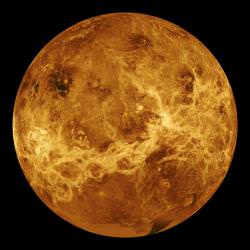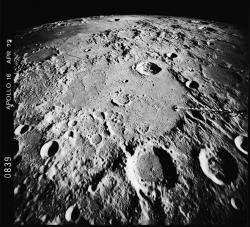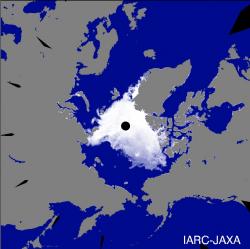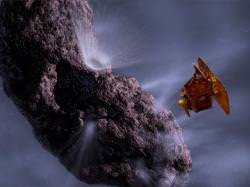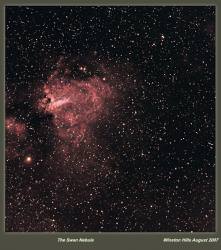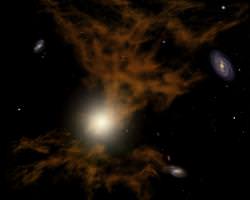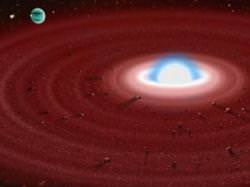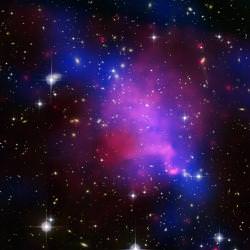Monday, August 20 – Our first order of business for the evening will be to pick up a lunar club challenge that we haven’t noted yet – Hipparchus.
Located just slightly south of the central point of the Moon and very near the terminator, this is not truly a crater – but a hexagonal mountain-walled plain. Spanning about 150 kilometers in diameter with walls around 3320 meters high, it is bordered just inside its northern wall by crater Horrocks. This deep appearing “well” is 30 kilometers in diameter and its rugged interior drops down an additional 2980 meters below the floor. To the south and just outside the edge of the plain is crater Halley. Slightly larger at 36 kilometers in diameter, this crater named for Sir Edmund is a little shallower at 2510 meters deep – but it has a very smooth floor. To the east you’ll see a series of three small craters, the largest of which is Hind.
Now, relax! Tonight is the peak of the Kappa Cygnid meteor shower. Although the Moon will interfere early in the evening, wait until it has set and watch the area near Deneb. Discovered in the late 1800’s, the Kappa Cygnids are often overlooked because the grander, more prolific Perseids tend to get more attention. Although the stream has been verified, peak dates and fall rates vary from year to year. The average fall rate is usually no more than 5 per hour, but it is not uncommon to see 12 or more per hour with many fireballs. The stream’s duration is around 15 days. Clear skies!
Tuesday, August 21 – When we begin our observations tonight, we’ll start by having a look at another great study crater – Archimedes. You’ll find it located in the Imbrium plain north of the Apennine Mountains and west of Autolycus.
Under this lighting, the bright ring of this class V walled plain extends 83 kilometers in diameter. Even though it looks to be quite shallow, it still has impressive 2150 meter high walls. To its south is a feature not often recognized – the Montes Archimedes. Though this relatively short range is well eroded, it still shows across 140 kilometers of lunar topography. Look for a shallow rima that extends southeast across Palus Putredinus towards the Apennines. Mark your challenge notes!
Now let’s go have a look at a star buried in one of the spiral arms of our own galaxy – W Sagittarii…
Located less than a fingerwidth north of Gamma, the tip of the “teapot spout,” W is a Cepheid variable that’s worth keeping an eye on. While its brightness only varies by less than a magnitude, it does so in less than 8 days! Normally holding close to a magnitude 4, nearby field stars will help you correctly assess when minimum and maximum occur. While it’s difficult for a beginner to see such changes, watch it over a period of time. At maximum, it will be only slightly fainter than Gamma to the south. At minimum, it will be only slightly brighter than the stars to its northeast and southwest.
While you watch W go through its changes – think on this: not only is W a Cepheid variable (a standard for distance measurements), but it is also one that periodically changes its shape. Not enough? Then think twice… Because W is also a Cepheid binary. Still not enough? Then you might like to know that recent research points toward W having a third companion as well!
Wednesday, August 22 – Tonight as the skies darken, look for Antares less than a degree north of moon. For some areas of the world, this could be an occultation event so be sure to check IOTA… And while you’re watching, check out Jupiter about 5 degrees further to the north!
Tonight will be another opportunity to note a lunar challenge feature you may have missed earlier in the year – The Straight Wall. Begin in the lunar south where you can’t miss the outstanding rings of craters Ptolemaeus, Alphonsus, Arzachel, Purbach and Walter descending from north to south. To the west, identify the beginnings of Mare Nubium. Look between Purbach and Walter for the small, bright ring of Thebit and further west and for a long, thin, dark “line” cutting across the mare. It is properly known as Rupes Recta – but more commonly called “The Straight Wall.” It’s one of the steepest slopes on the lunar surface and only visible when the lighting is just right. If you can’t see it tonight, try again in 15 days when the sunlight changes the viewing angle!
Although it will be tough to locate with the unaided eye thanks to the Moon, let’s take a closer look at one of the most unsung stars in this region of sky – Eta Sagittarii. This M-class giant star will show a wonderful color contrast to binoculars or scopes, being slightly more orange than the surrounding field. Located 149 light-years away, this irregular variable star is a source of infrared radiation and is a little larger than our own Sun – yet 585 times brighter. At around 3 billion years old, Eta has either expended its helium core or just begun to use it to fuse carbon and oxygen – creating an unstable star capable of changing its luminosity by about 4%. But have a closer look… For Eta is also a binary system with an 8th magnitude companion!
Thursday, August 23 – Do you remember a few days ago in history when Lunar Orbiter 1 was launched? Well, on this day in history it made headlines as it sent back the very first photo of Earth seen from space!
Tonight let’s do a little lunar orbiting of our own as we head to the western shore of Mare Cognitum and look along the terminator for the Montes Riphaeus – “The Mountains In The Middle of Nowhere.” But are they really mountains? Let’s take a look.
At the widest, this unusual range spans about 38 kilometers and runs for a distance of around 177 kilometers. Less impressive than most lunar mountain ranges, some peaks reach up to 1250 meters high, making these summits about the same height as our volcano Mt. Kilauea. While we are considering volcanic activity, consider that these peaks are all that is left of Mare Cognitum’s walls after lava filled it in. At one time this may have been amongst the tallest of lunar features!
Now let’s have a look at the brightest star in the “Archer” – Epsilon Sagittarii. Known as Kaus Australis, or the “Southern Bow,” Epsilon holds a respectable magnitude 1.8 and is located around 120 light-years from Earth. This sparkling blue/white star is 250 times brighter than our own Sun. While a major challenge would be to spot Epsilon’s 14th magnitude companion star located about 32″ away, even the smallest of telescopes and most binoculars can try for the 7th magnitude visual companion widely spaced to the north-northwest.
Friday, August 24 – Today in 1966 from an Earth-orbiting platform, the Luna 11 mission was launched on a three day trip. After successfully achieving orbit, the mission went on to study many things, including lunar composition and nearby meteoroid streams.
Tonight let’s start our lunar observations with features that can be seen with both binoculars and telescopes. Just slightly north of center along the terminator, look for the bright point of Kepler. Watch as this feature develops a bright ray system in the coming days. To the north you will see equally bright Aristarchus – quite probably one of the youngest of the prominent features at around 50 million years old. It will also develop a ray system.
Now, grab your telescope and look west of Aristarchus for less prominent crater Herodotus. Just to the north you will see a fine white thread known as Vallis Schroteri – or Schroter’s Valley. Winding its way across the Aristarchus plain, this feature is about 160 kilometers long, from 3 to 8 kilometers wide, and about 1 kilometer deep – but what is it?
Schroter’s Valley a prime example of a collapsed lava tube – created when molten rock flowed over the surface. This may have been from a major meteor strike, such as the formation of Aristarchus crater, or early volcanic activity. What is left is a long, narrow cave on the surface which only shows well when the lighting is correct. Like many sinuous rilles covering the surface, collapse has occurred. If intact tubes can be found on the lunar surface they could conceivably provide shelter for future settlers!
Saturday, August 25 – Tonight we’ll start our observations in the lunar southwest as we look along the terminator to identify challenge crater Schickard. Look for an elongated grey oval that’s more than just another cool crater…
Named for Dutch mathematician and astronomer Wilhelm Schickard, this 227 kilometer diameter feature is a ringed plain and very old. At high power you’ll see a variegated floor and dark areas near the walls – yet the center is creased by a lighter coloration. It is believed Schickard was formed by an early impact before Mare Nectaris formed. Its floor may have contained vents which allowed it to fill with lava during the Imbrium period. As it cooled and matured another impact event occurred nearby which formed the Orientale Basin and splashed material its way. But Schickard wasn’t done evolving yet… Lava continued to flow and left even more dark evidence for us to observe. How do we know this is so? If you’re able to resolve Schickard’s tiny interior impacts, you’ll see that far fewer of them occur over newer material. Older formations bear the scars of time and impact while younger features are fresh and unmarked!
Tonight is also the peak of the Northern Iota Aquarid meteor shower. While the Moon will totally interfere, you still might catch a bright streak!
Sunday, August 26 – Tonight we’ll continue our journey of lunar evolution as we have a look at another walled plain just south of Grimaldi.
Named for English naturalist Charles Darwin, this equally old feature bears the scars of the impact the created the Orientale Basin. Look carefully at the slopes in the northeast, for this may very well be material that was thrown there and left to slide back down to the crater floor. Spanning around 130 kilometers in diameter, Darwin’s actual size is only diminished by the fact that we view it on a curve. Its northern and southern shores have almost completely eroded, yet evidence remains of its eastern margin broken by the Rima Darwin which stretches for 280 kilometers. Was there lava here as well? Yes. Evidence still exists in the form of a dome along Darwin’s battered western edge.
On this date in 1981, Voyager 2 made a fly-by of Saturn. Eight years later in 1989, Voyager 2 flew by Neptune on this date. Why don’t we make a “date” tonight to have a look at this distant blue world? You’ll find it on the ecliptic plane east of the Moon. While large binoculars can pick up Neptune’s very tiny blue orb, you’ll need a telescope tonight to spot it through the lunar glare.

